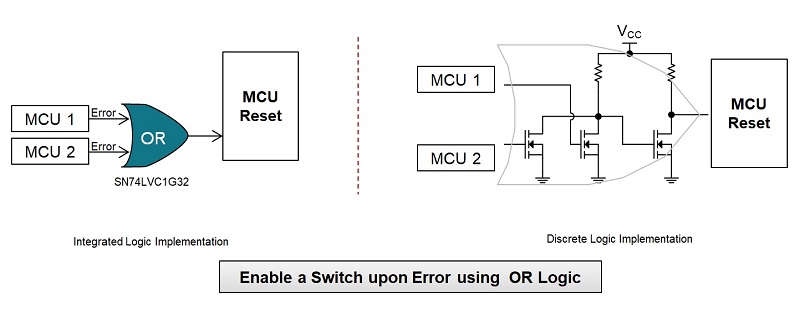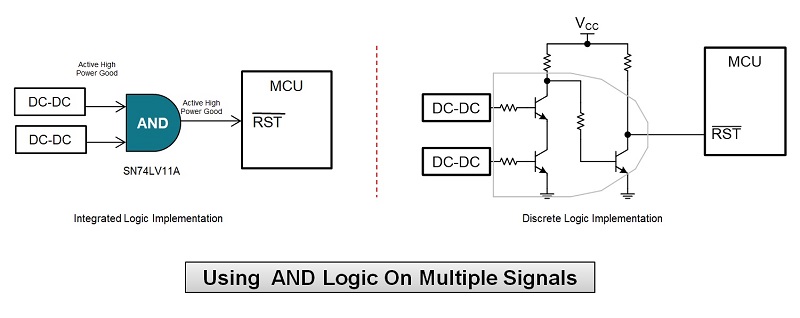By Atul Patel, product marketing, Texas Instruments, www.ti.com
Using digital logic gates such as AND, OR, XOR, NOT, NAND, NOR, and XNOR and other related logic functions is often the foundation for defining the relationship between electrical signals and how they connect with one another in any electronic system. Logic gates are essential building blocks in enabling larger and more complex devices like microprocessors, field-programmable gate arrays (FPGAs), and other digital devices to perform their intended functions optimally.
Logic gate functions enable system designers to take similar core electronic components and develop totally different end products. For example, a simple combination of a microcontroller, sensors, input/output (I/O) devices, and power management can become a temperature monitor, a thermostat, a digital thermometer, or multiple other devices, with logic gates playing a key role in combining the signals between the core components in different ways that result in unique applications.
There is no doubt that logic gates by themselves are some of the simplest electronic components and are often not at the forefront of any system design consideration. But they are key devices in helping system designers transform a set of electronic components into an application that can save a life, avoid a car crash, take a picture or help complete an infinite number of other tasks.
Many engineers develop their own repertoire of logic function implementations throughout their careers based on past experiences and challenges. You may use discrete components such as resistors and field-effect transistors (FETs) to implement logic functions such as AND, OR, NOR, and XOR, as well as simple voltage-level shifting. Although the approach of using discrete components to implement logic functions has been declining, you may still rely on discrete logic gate implementations in your electronic system designs.
Discrete logic function implementations have remained popular due to their relative simplicity and the engineering community’s overall familiarity with discrete components. In recent years, integrated or dedicated digital logic integrated circuits (ICs) have made tremendous strides in terms of size, power, cost, ease of design, and functional integration. Today, for many applications, logic ICs offer a better system-level value proposition than discrete resistors and transistors.
Unfortunately, many engineers are missing out on the benefits of dedicated logic functions due to the “inertia” associated with the familiar discrete approaches. Logic ICs can help you improve your designs and achieve design targets by reducing component count, reducing printed-circuit board (PCB) area, and increasing system flexibility and robustness, resulting in overall lower life-cycle costs for an application. Let’s dive a little deeper into all four of these advantages over discrete logic function implementations.
Component count
The number of electronic components (such as ICs, passives, and discrete devices) used to implement the functionality of an electronic device or system plays a critical role in determining market success. Modern electronic systems are often designed to meet multiple design targets such as low power dissipation, smaller form factor, lower development cost, reduced unit cost, and enhanced thermal performance.
To illustrate the impact of component count differences between discrete logic function implementations and integrated logic IC implementations, Fig. 1 shows a simple logic selection in which two signals need to have an OR function to communicate error signaling within a system.

Fig. 1: Two-input OR gate function implementation using integrated and discrete solutions.
As Fig. 1 shows, the discrete approach uses five components while the integrated solution uses a single IC to implement the OR function. What does this mean for the system? The discrete approach with its five components tends to be much less efficient than the integrated approach.
Consider applications such as low-power modes that need very low current leakage from the system components to maximize battery life or meet energy-usage targets. More discrete components often mean lower power efficiency. More components also mean more potential points of failure, which translates to lower system reliability and thus higher warranty and service costs. Fewer components means fewer devices to qualify and source for a design. Using integrated logic IC functions enables system designers to reduce system component count, which can benefit a design in multiple ways that far exceed the component costs of an implementation.
PCB area
PCB area can also impact system form factor, system build cost, and feature set mix. Using discrete devices to implement a system’s control signals is quite common. However, discrete approaches may be costing precious board area that could potentially make the overall design smaller in terms of form factor and thus lower cost.
Fig. 2 shows a common example of implementing a power-good control signal from multiple devices. The discrete implementation uses eight discrete devices while the integrated logic gate requires a single IC. The discrete approach not only uses many devices, but the board space to interconnect those devices can consume much more space than the actual size of discrete components.
In many cases, a system may not be form-factor–sensitive. In such cases, saving PCB space with integrated logic gates can still be important as you can use the saved board area to add additional functionality to the application and differentiate your design from others in their respective markets. PCB area savings associated with using integrated logic gates versus discrete components can be an essential ingredient to help you meet and exceed your design goals.

Fig. 2: Two-input AND function: integrated vs. discrete comparison.
The impact of using logic ICs versus discrete devices is even more dramatic when implementing slightly more complex functions. For example, it’s possible to implement simple unidirectional push-pull level shifting using discrete N-channel and P-channel FET transistor devices, as well as using dedicated circuits designed for level shifting such as TI’s 2N7001T.
Fig. 3 compares a common discrete push-pull level-shifting implementation to an integrated implementation. The integrated implementation consumes 90% less board area than the discrete solution while also providing lower leakage, better signal performance, and a much simpler implementation. If the discrete level-shifter implementation appears in multiple places within a design, you can achieve considerable board space and power savings by simply moving to the integrated solution.

Fig. 3: Integrated vs. discrete level shifting.
Design flexibility and robustness
Using integrated logic gate solutions has additional benefits compared to discrete solutions that designers often overlook. Design flexibility is one of those benefits that can help immensely when design parameters change during design development.
Returning to the power-good implementation mentioned earlier (Fig. 2 ), what if the voltage levels for some of the signals changed from 1.8 V to 5 V? In this case, the discrete solution would require different component values to handle the different voltage levels. The integrated solution would not need to change because it can support a range of voltage levels between 1.8 V and 5 V.
Now imagine that this power-good circuit appears in 10 different places within a design. Changing the discrete solution in 10 places will consume valuable engineering time that can affect time to market, not to mention overall project cost. The design flexibility of integrated logic gate functions is a key benefit that can help you meet your design schedules and overcome design obstacles.
Discrete logic gate implementations by their nature involve many interconnected components that combine to accomplish a function. As seen from the examples above, even simple discrete implementations can involve more than eight different devices, while more complex implementations can have more than 20 components. The sheer number of components in a discrete design increases the chances of having a component failure or a poor solder joint that could result in the system malfunctioning. Fixing a malfunctioning system in the field can be very costly to system vendors. In addition, trying to repair a discrete circuit can be time-consuming in terms of finding the failing component in a sea of discrete devices. Using integrated logic gate solutions reduces the number of signal interconnects, which, in turn, reduces the number of interconnects that have the potential to fail. System robustness is another benefit that you can realize by selecting integrated logic gate and translation functions.
Design life-cycle cost
Up to now, we have discussed the individual benefits of using integrated logic gate functions compared to discrete solutions. However, the combined effect of these benefits is that you can reduce the overall life-cycle cost of the project. This cost includes not only the development cost but also the cost to repair and maintain the system over its useful life span. In addition, the cost of downtime can be substantial and should also be a consideration when weighing the benefits of a more robust system. System designers, architects, and component engineers need to consider the combined benefits of integrated logic solutions when selecting, implementing, and sourcing logic functions for their designs.
How can you use this information for your next project? Just understand where you are using discrete devices to implement logic functions in your design and then map those functions to the vast array of integrated logic solutions available today. A source of integrated logic solutions is the logic and translation landing page , where you can find many different families of logic gate solutions. Explore the integrated logic solutions that are available to help complete your design.
Advertisement
Learn more about Electronic Products MagazineTexas Instruments





